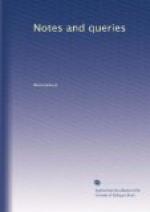H.E.
Rococo.—Would any correspondent of “NOTES AND QUERIES” give the history of this word, or indicate where it is to be found? or, if the history is not known, state when, and by whom, it appears to have been first used?
T.
Oxford.
Howlett the Engraver.—Can any of your readers furnish me with an account of the “Publications of Bartholomew Howlett,” who was an engraver of some note, and about forty-five or fifty years ago resided in London? He was a native of Louth in Lincolnshire, and about forty-five years ago, being then resident (as appears from his book) somewhere in the neighbourhood of the Blackfriars’ Road, published by subscription a book containing a series of engravings, entitled “Views in Lincolnshire.”
L.L.L.
The Bear, the Louse, and Religion.—I should be much obliged to any of your correspondents who will inform me where I can find The Bear, the Louse, and Religion: a fable. It commences—
“A surly Bear, in college
bred,
Determin’d to attack
Religion;
A Louse, who crawl’d
from head to head,
Defended her—as
Hawk does pidgeon.
Bruin Subscription discommended;
The Louse determin’d
to support it—”
I know no more. When was it written?—upon what occasion?—who are meant by the Bear and the Louse?
GRIFFIN.
Mar. 5. 1850.
* * * * *
REPLIES.
LETTER ATTRIBUTED TO SIR R. WALPOLE.
There are many reasons, drawn from style and other internal evidence, which induce P.C.S.S. to entertain strong doubts as to the authenticity of the letter attributed to Sir Robert Walpole (and reprinted from Bankes) in No. 19. Among others it seems very unlikely that a prime minister, confidentially addressing his sovereign (and that sovereign George II.!) on a matter of the greatest import, would indulge in a poetical quotation. And it is remarkable that neither the quotation in question, not any thing at all resembling it, in thought or expression, is to be found in any part of Fenton’s printed works. P.C.S.S. has carefully looked them over, in the editions of London, 1717, and of 1810 (Chalmer’s Collection, vol. x.), and he cannot discover a trace of it. He had at first imagined that it might be successfully sought for in Fenton’s admirable Epistle to William Lamborde (the Kentish antiquary), where there is a remarkably fine passage respecting flattery and its influences; but nothing at all like the quotation cited in the letter is to be found in that poem, which (par parenthese) seems to have met with much more neglect than it deserves.
P.C.S.S. would further notice the great improbability that Walpole would committed himself in writing, even to his royal master, by such a display of perilous frankness, in treating of the private character and principles of his great rival. He must have been aware that the letter would, most probably, at the decease of the king (then advanced in life) have been found among his majesty’s papers, and, with them, have passed into the hands of his successor, by whom it would undoubtedly have been communicated to the very individual with whom it so hardly dealt.




